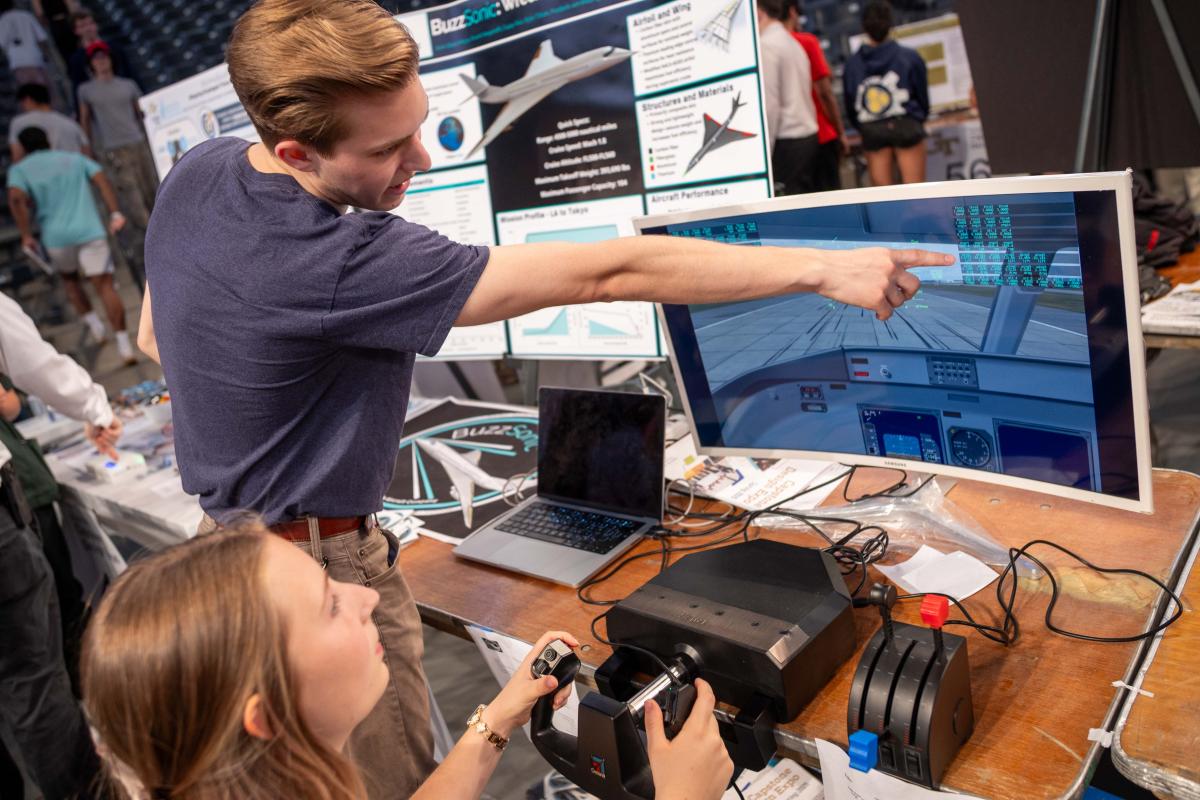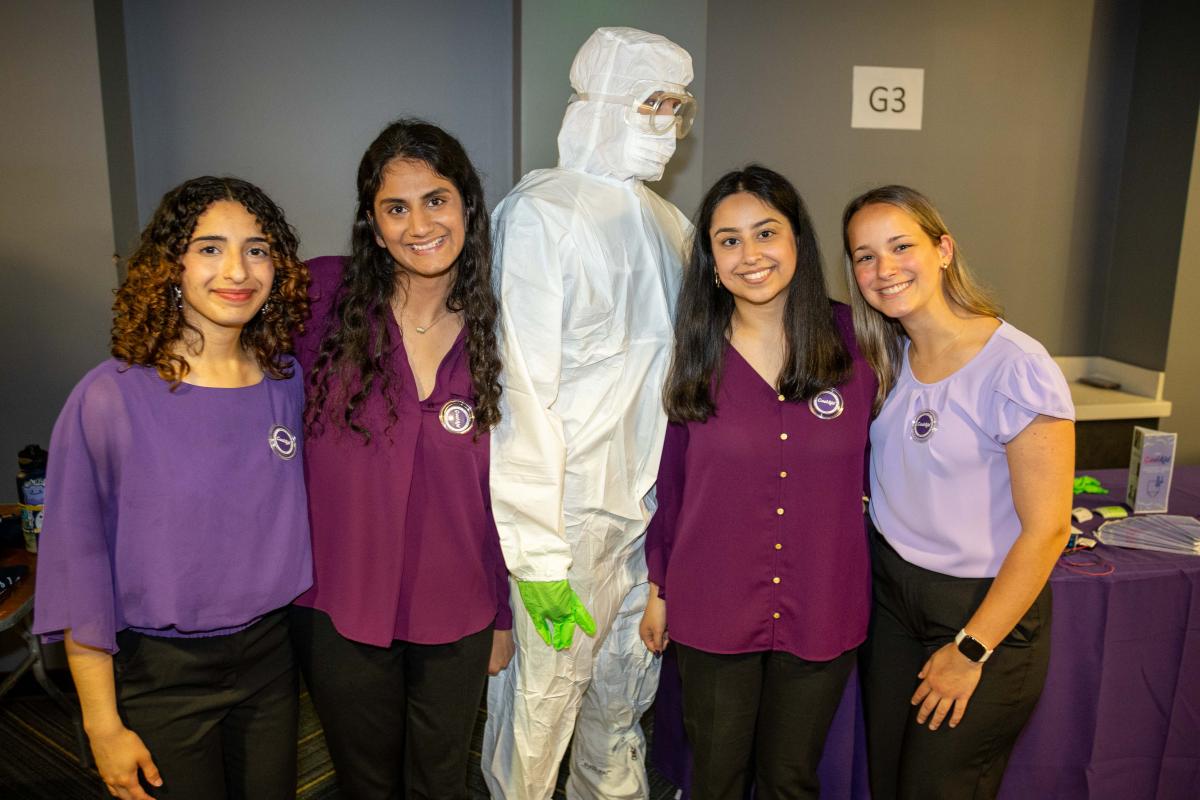The showcase of senior design projects included projects from a record 238 teams across four colleges.
(text and background only visible when logged in)

One-Hand Wonder was the overall winner of the Spring 2025 Capstone Design Expo, which featured a record number of teams.
(text and background only visible when logged in)
Sometimes the best ideas come from working somewhere no one else is. That certainly was the case for the team judged the best overall project at the Spring 2025 Capstone Design Expo April 22.
Their quick-to-adjust surgical retractor is designed to more easily pull back skin and tissue during head and neck surgeries to allow doctors to access deeper muscles, organs, and other tissues. Current devices require surgical assistants to hold them for hours or the use of cumbersome stands, and they require significant effort to adjust.
Yet no one seemed to be innovating in the area until Emory Healthcare ear, nose, and throat surgeon David Chou brought the idea to the team to come up with something better.
“What really makes this project so interesting is its focus on not just safety and efficiency, but on innovation as a whole, and innovating in an area no one was thinking about,” said Stefano Poma, one the members of Team RapidReach. “Our sponsor had this vision of a better option with faster adjustment times. And that really is where our idea came in. It was a lot of overturning the current designs and coming up with a whole new idea from scratch.”
The concourses of Georgia Tech’s McCamish Pavilion were full of other new ideas during this spring’s Expo. A record 238 teams of more than 1,300 students showed off their semester-long projects that serve as a culmination of their undergraduate studies.
(text and background only visible when logged in)
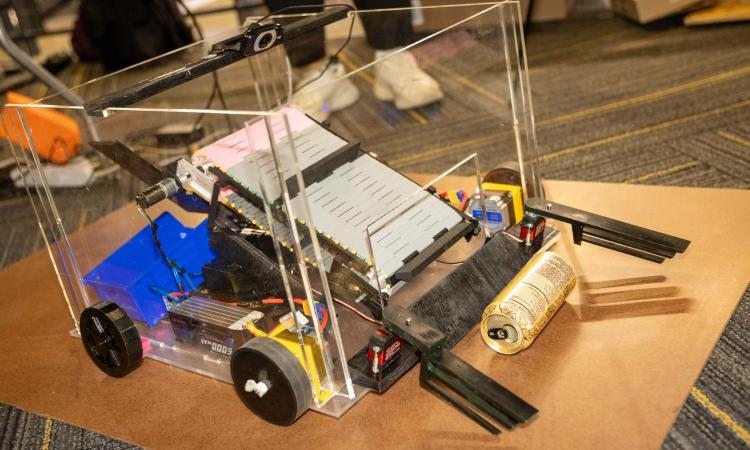
See More Photos
A look at more projects and teams from the spring Expo.
(text and background only visible when logged in)
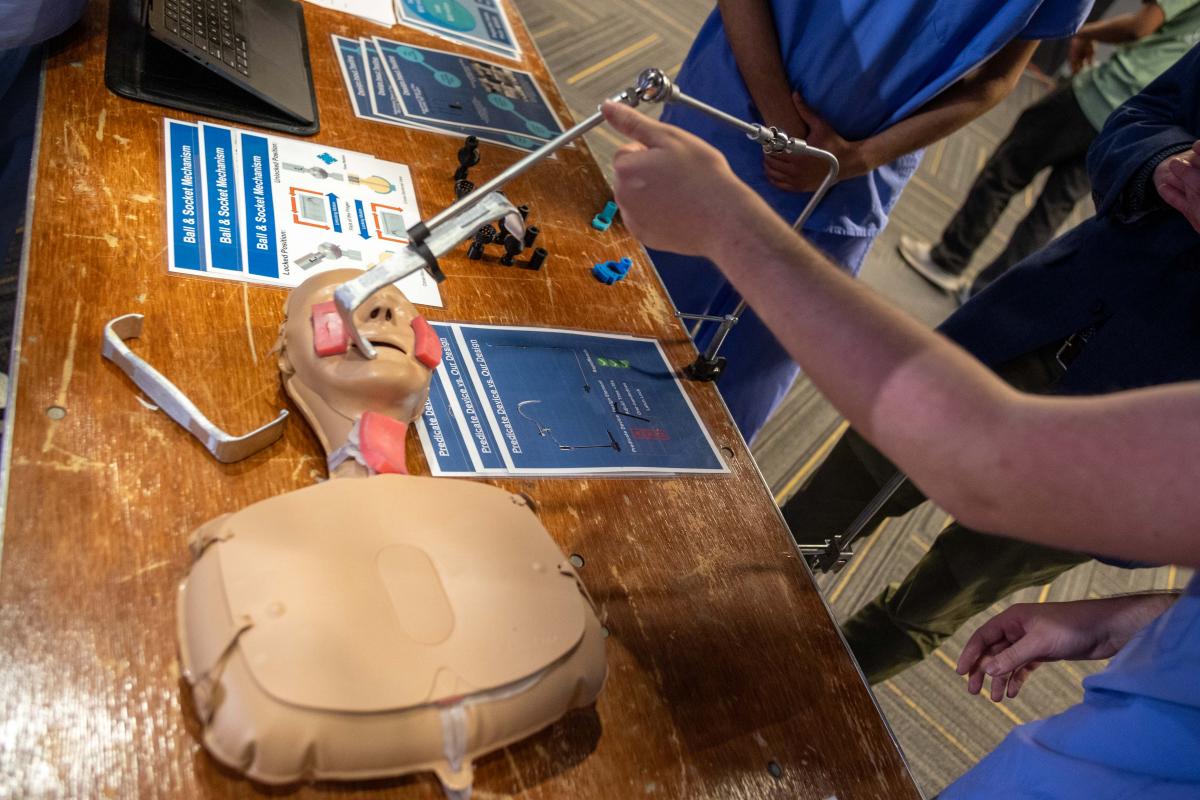
The overall winner, the RapidReach device, is a quick-adjust, one-handed surgical retractor arm.
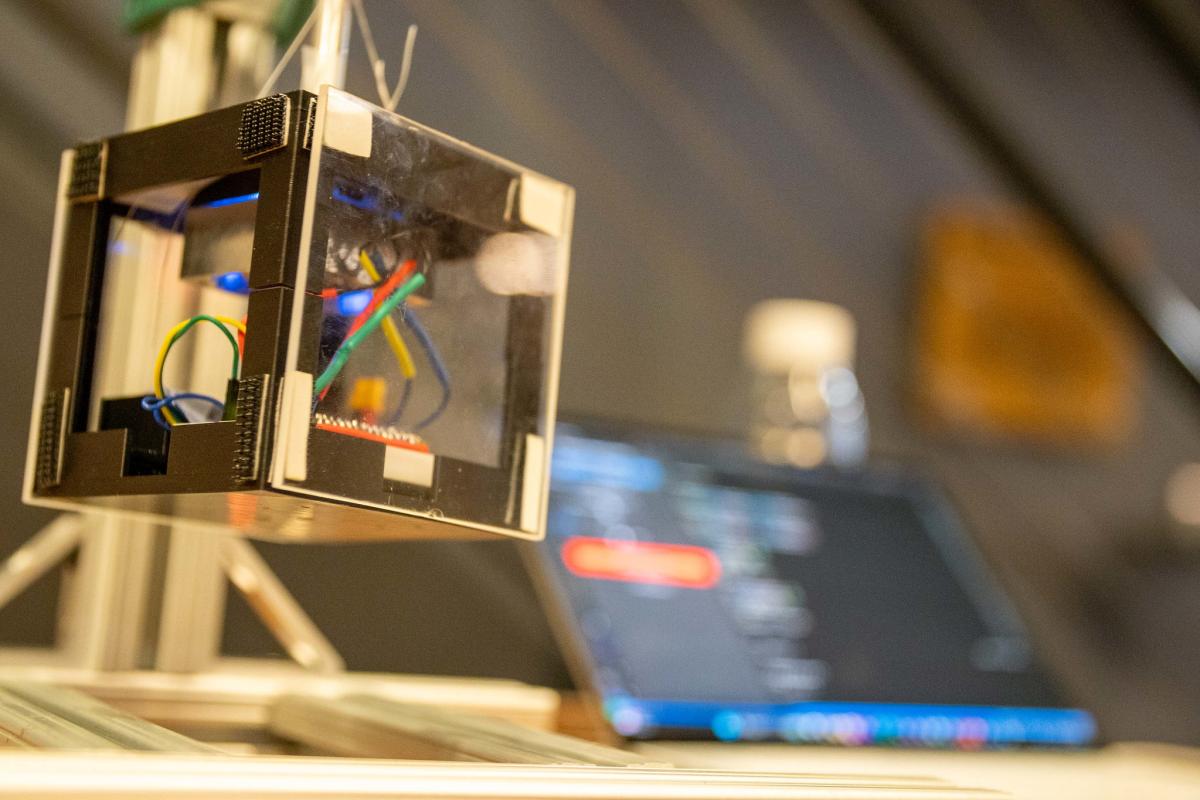
The top interdisciplinary team, Team Space Wheels, developed a high-performance, low-cost CubeSat reaction wheel.
Projects spanned seven of the eight schools in the College of Engineering as well as students in computing, design, and liberal arts. Judges selected the top project from each discipline and a series of honorable mentions alongside a top interdisciplinary group Team RapidReach’s best overall project.
The surgical retractor was the work of a team of biomedical engineering students: John Cutrone, Dawei Liu, Michael Pavelchek, Poma, and Rohan Ravula.
In the end the group settled on a ball-and-socket joint design with sliding pins that allows for easy one-handed adjustments mid-surgery. Testing with medical students and residents showed it was quick to learn how to use and reduced the time to shift the retractor from a minute or two to just a few seconds.
It would be useful for procedures such as thyroid gland removal, facial reconstruction, and plastic surgeries on the nose or face, for example.
“Our device reduces the number of operators that are needed, particularly in low resource settings. You just cannot have an additional person because that costs too much money,” Ravula said.

Students on the Hyundai Interface Project are making recommendations to the company for a new visual and functional design system for the IONIQ 6.
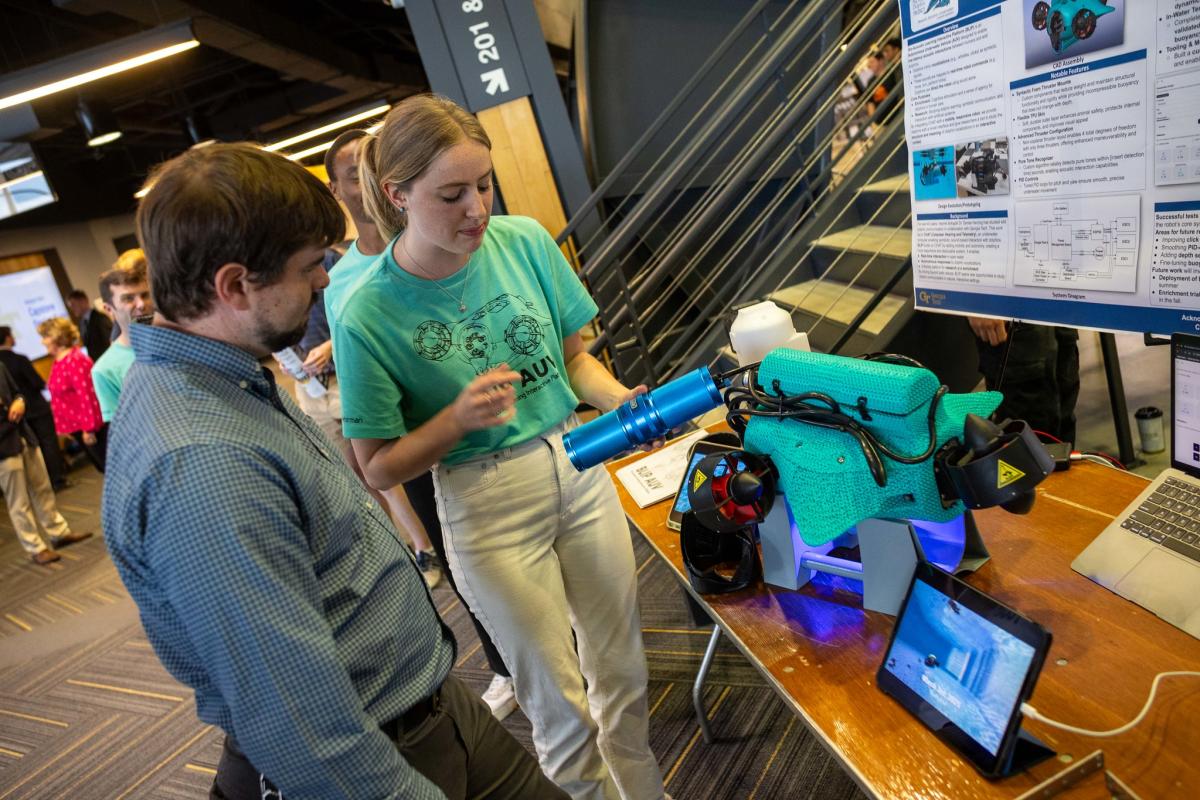
The Dolphin ChatBOT Sub is an interactive, whistle-controlled robotic system to advance dolphin communication research.

RowRider is an autonomous weeding solution for small organic vegetable farms.
The best interdisciplinary project award went to an inexpensive design for a CubeSat orientation system called a reaction wheel. Created by a team of electrical, computer, and mechanical engineers, the design cost a fraction of the amount of traditional reaction wheel systems.
It’s specifically intended for a class of small satellites called CubeSats that have become a popular tool for quickly advancing space technology. Georgia Tech has launched a number of the briefcase-sized spacecraft, and they often use common components to keep costs down.
“Newer university satellites are moving to using consumer electronics, which are cheap,” said team member Daniel Vail, an electrical engineering major. “They’re the same sorts of components used in toys or other devices. But there’s no equivalent of that for a reaction wheel, because it’s something that would only ever be used on a satellite.”
A typical reaction wheel can run in the $10,000 to $15,000 range. Vail and his teammates — computer engineer Fahd Aly, mechanical engineer Emily Winters, and electrical engineers Taylor Frankum, Susannah Gordon, and James Shin — built one for about $1,000.
“It’s not the parts that make it expensive; it’s the fact that it’s produced for space,” Vail said. “When you can take maybe a 1% risk of this failing, then you can reduce the cost significantly.”
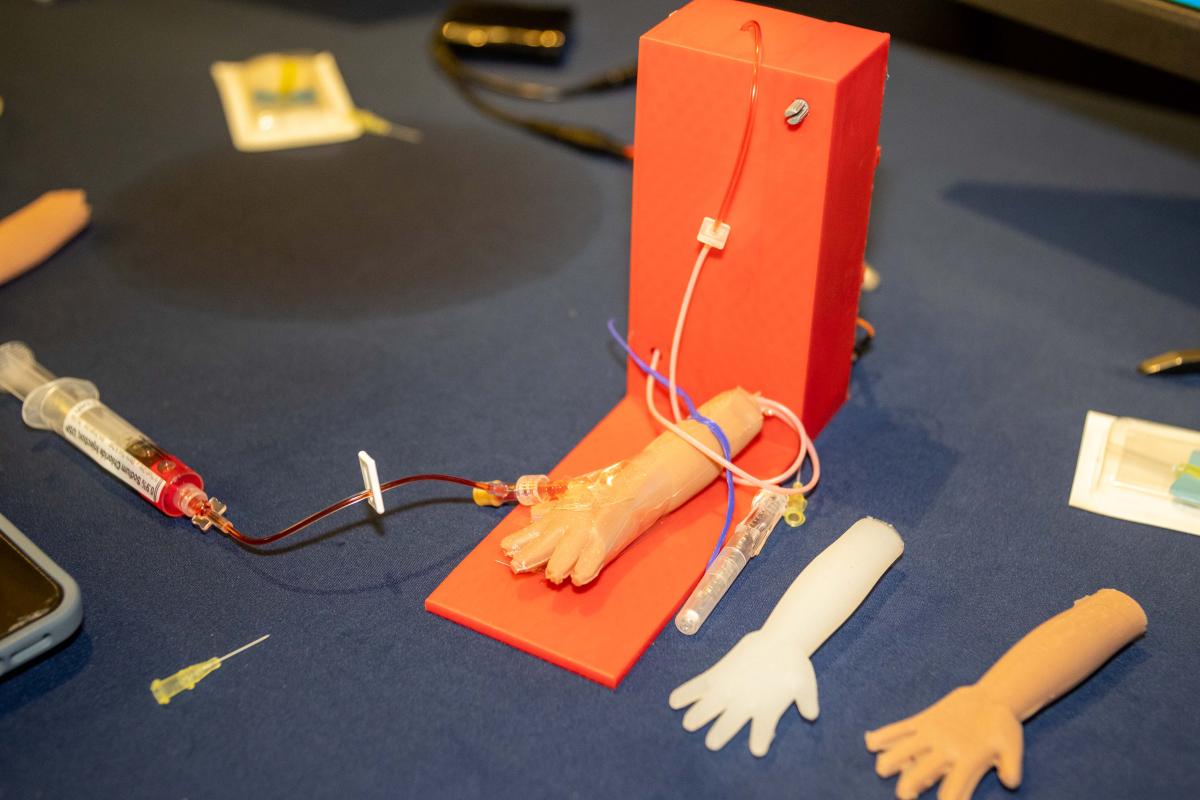
MissionMannequin allows nurses to practice IV insertions for newborn babies, who have small and fragile veins.
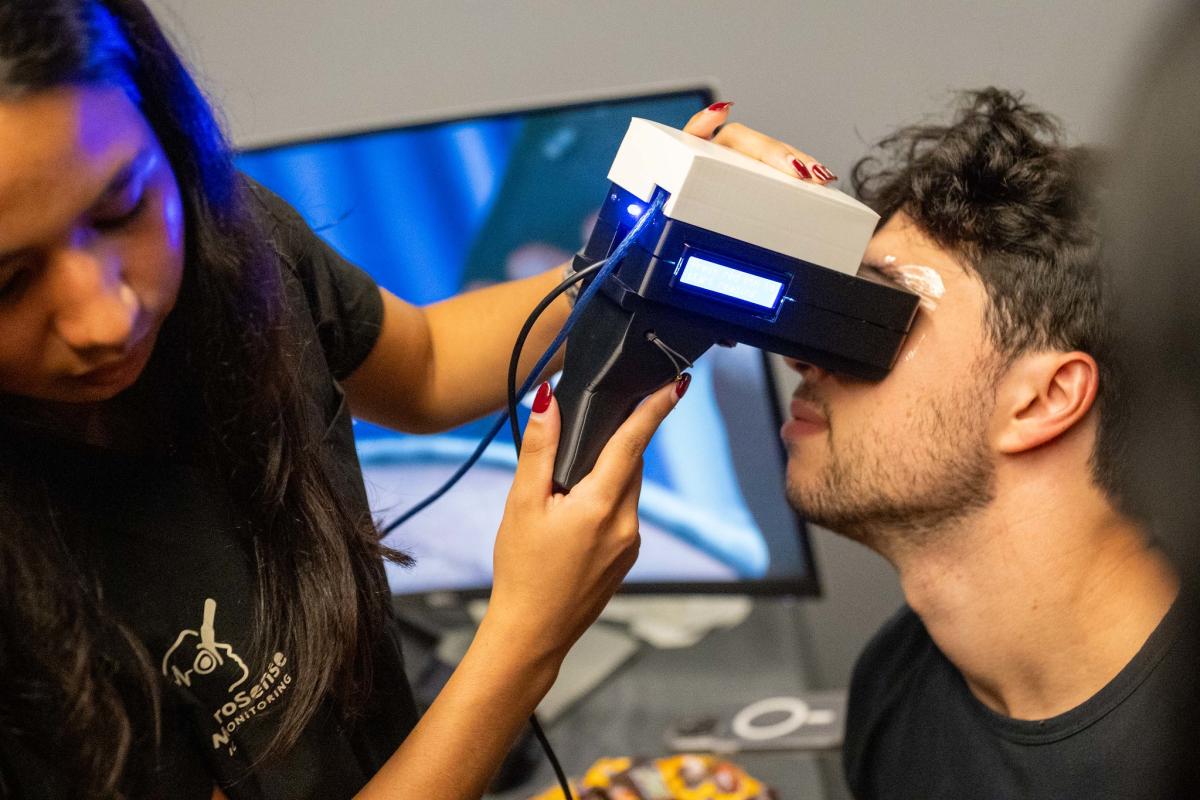
NeuroSense is a non-invasive device to measure intracranial pressure via the optic nerve sheath.
Elsewhere across McCamish, students displayed an assistive writing device to help people with chronic pain or conditions that affect grip strength and hand dexterity and a smarter cane to improve autonomy for visually impaired people.
There were robots to sort trash and recyclables and clean windows. One team created a comfortable cooling garment for outdoor workers that also can alert users to signs of heat stress. Two others designed blinds for high-rise building windows that capture energy and convert it to usable electricity for residents.
Lost car keys or TV remote? Students had a solution. Having trouble with your air conditioning? One device can diagnose the issue and estimate what it’ll cost to repair.
There was an automated tourniquet designed for military and law enforcement personnel that significantly reduced the time to control bleeding in life-threatening situations. And an anchoring system to allow wheelchair users to enjoy low-intensity theme park rides without having to move out of their chair.
Students explored more … unusual … ideas. Consider the group that created an artificial mucus akin to the human stuff. The idea was to help medical device companies have a realistic analog for testing potential products.
Teams also helped several hometown Atlanta companies — helping improve flavor innovation at Coca-Cola, engine work at Delta Airlines TechOps, and ticket sales and promotions for the Atlanta Braves.
Almost 60% of the teams at the spring Expo worked on projects for industry sponsors. The Capstone Design program also is supported by philanthropic donations that are part of Transforming Tomorrow: The Campaign for Georgia Tech, a more than $2 billion comprehensive campaign designed to secure resources that will advance the Institute and its impact — on people’s lives, on the way we work together to create innovative solutions, and on our world — for decades to come.
See all the winners from Capstone Expo below and visit expo.gatech.edu for more projects.
(text and background only visible when logged in)
(text and background only visible when logged in)
Capstone Results
One-Hand Wonder
OVERALL BEST PROJECT
RapidReach: A flexible, quick-adjust, and one-handed surgical retractor arm
- John Cutrone, BME (Columbus, GA)
- Dawei Liu, BME (Toledo, OH)
- Michael Pavelchek, BME (Ossining, NY)
- Stefano Poma, BME (Marietta, GA)
- Rohan Ravula, BME (North Brunswick, NJ)
Space Wheels
INTERDISCIPLINARY
Low-cost cubesat reaction wheel
- Fahd Aly, CmpE (Dallas)
- Taylor Frankum, EE (Macon, GA)
- Susannah Gordon, EE (Knoxville, TN)
- James Shin, EE (Savannah, GA)
- Daniel Vail, EE (Columbus, NJ)
- Emily Winters, ME (Duluth, GA)
Team Alpha
DANIEL GUGGENHEIM SCHOOL OF AEROSPACE ENGINEERING
Conceptual aircraft design of a Homeland Defense Interceptor (HDI) vehicle
- Ethan Das (Ponte Vedra Beach, FL)
- Mark Gorrow (Dallas, GA)
- Jacob Labaza (Cary, NC)
- Dmitri Palmer (Athens, GA)
- Papa Quainoo (Jonesboro, GA)
- Calvin Tomsic (Everett, WA)
Urban Roots
SCHOOL OF ARCHITECTURE
A framework that localizes food, water, and energy systems
- Nour Khalifa (Atlanta)
- Adara Houlihan Tahan (Portland)
Pull My Finger
WALLACE H. COULTER DEPARTMENT OF BIOMEDICAL ENGINEERING
The Tendon Trap: An implant to keep tendons in place after surgery
- Peter Chapman (Peachtree City, GA)
- Hannah Gordy (Savannah, GA)
- Olivia Loris (Sharpsburg, GA)
- Ava Paikeday (Alpharetta, GA)
- Bennett Steedley (Knoxville, TN)
Blue Whale Solutions
SCHOOL OF CIVIL AND ENVIRONMENTAL ENGINEERING
Soil vapor extraction for the Velsicol Chemical Corp. Superfund Site
- William Caldwell, CE (Decatur)
- Rebecca Chapman, EnvE (Atlanta, GA)
- Hudson McGaughey, EnvE (Atlanta)
- Melanie Reveron, EnvE (Miami, FL)
GaN-FET BLDC Controller
ELECTRICAL AND COMPUTER ENGINEERING
Controller for advanced UAV systems
- Justin Barker, EE (Webster Groves, MO)
- Noah Kim, EE (Suwanee, GA)
- Ted Paek, CmpE (Suwanee, GA)
- Lawrence Ro, EE (Houston, TX)
- Asiauana Spikes, EE (Macon, GA)
Grand Slammers
H. MILTON STEWART SCHOOL OF INDUSTRIAL AND SYSTEMS ENGINEERING
Optimizing promotion placement for the Atlanta Braves
- Ethan Asbell (Milledgeville, GA)
- Oliver Davidson (Atlanta, GA)
- Tyler Hankin (Atlanta, GA)
- Bre Kaplan (Duluth, GA)
- Apoorva Mahendranath (Greenville, SC)
- Diego Mora (West Palm Beach, FL)
- Anna Taylor (Elmhurst, IL)
- Hailey Toeppner (Milton, GA)
Hyundai
INDUSTRIAL DESIGN AND ENGINEERING (TIE)
Recommendations for Hyundai’s interface system
- Michael Harrington, EE (Fort Lauderdale)
- Clarissa Kim, ID (Tokyo)
- Edmond Li, CmpE (Orlando)
- Xiaoyang Wang, ID (Irvine)
- Adamson Whitney, ID (Atlanta)
- Zixin Zhou, ID (Hangzhou, China)
GT-LAU Makerspace Kit Team
INDUSTRIAL DESIGN AND ENGINEERING (TIE)
A makerspace kit for Lebanese school children
- Adian Basalay, ID (Duluth)
- Yeji Han, ME (Duluth, GA)
- Alexander Hom, ME (Syosset, NY)
- Dingmohen Li, ME (Bryn Mawr)
- Iretomide Olayeye, ID (Dacula)
- Jared Teiger, ID (Ojai)
Silpara I
SCHOOL OF MATERIALS SCIENCE AND ENGINEERING
3D printing a bio-based rubber tread
- Abigail Horton (Bethlehem)
- Nora O'Kelly (Atlanta)
- Eric Samelo (Montgomery)
- Tina Tran (Alpharetta)
- Johnathan Wright (Morrisville)
DirtWorks
GEORGE W. WOODRUFF SCHOOL OF MECHANICAL ENGINEERING
RowRider: an autonomous weeding solution
- Luke Barnes (Johnson City, TN)
- Stephen Britten (Clarksville, MD)
- Katherine Ciavola (Greensboro, GA)
- Bryn Shannon (Richmond, VA)
- Priya Soneji (Roswell, GA)
NOMAD
NUCLEAR AND RADIOLOGICAL ENGINEERING
Nuclear Optical Measurement-Acoustic Detector
- Malachi West (Kennesaw, GA)
- Noah Woodyard (Valparaiso, IN)
- Garrett Youngblood (Ninety Six, SC)
Risky Business
SCHOOL OF PUBLIC POLICY
City of Woodstock community risk assessment
- James Connor (Northport, NY)
- Sarah McCoy (Marietta, GA)
- Gabrielle Meeks (Smyrna, GA)
- Nick Muir (Lawrenceville, GA)
- Lindsey Snyder (Atlanta, GA)
(text and background only visible when logged in)
Honorable Mentions
- Energy Analysis Team, Interdisciplinary
- AutoStitch, Interdisciplinary
- BECMJackets, Interdisciplinary
- Team Capy, ME
Related Stories
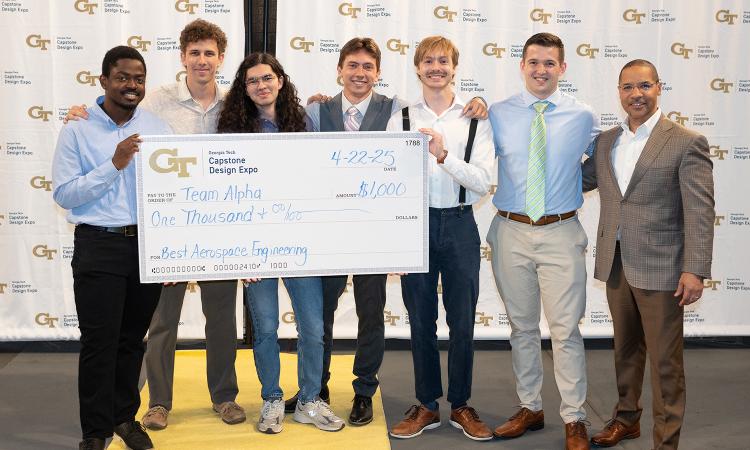
Team Alpha Captures Top Aerospace Engineering Prize
The team conceptualized a highly efficient aircraft for homeland defense.
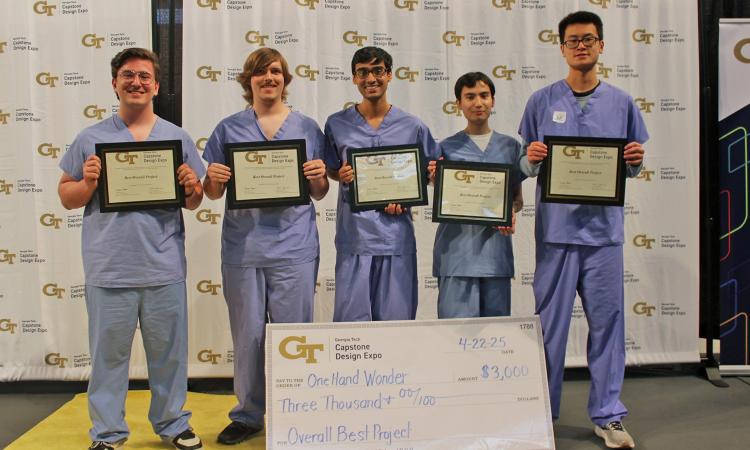
Retractable Arm Device Places First at Spring Capstone Expo
The surgical support device landed Coulter BME its 4th consecutive win for the competition.
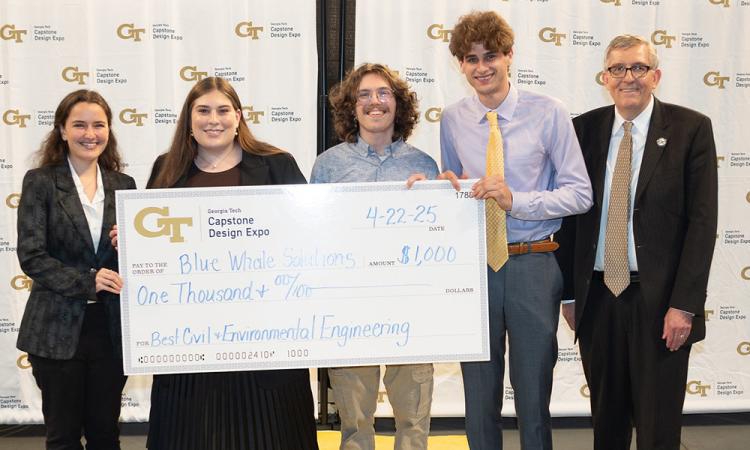
CEE Students Showcase Innovation at Capstone Design Expo
Blue Whale Solutions won top prize among CEE teams for their soil vapor extraction project.
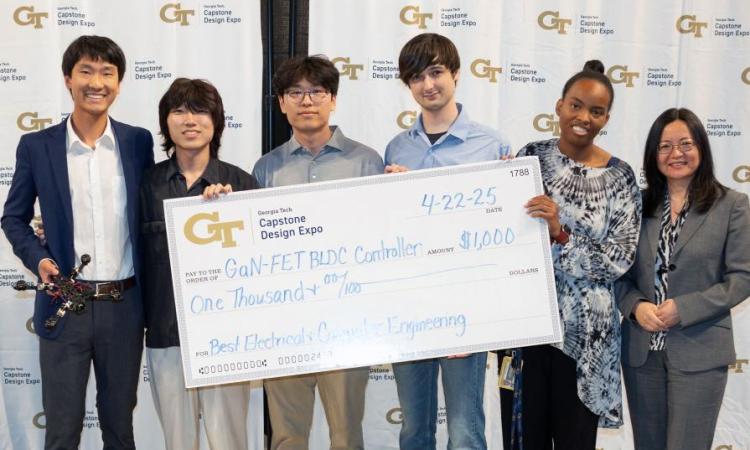
Efficiency and Affordability Drive Groundbreaking ECE Projects
The application of gallium nitride semiconductors in UAVs took top honors among ECE projects.
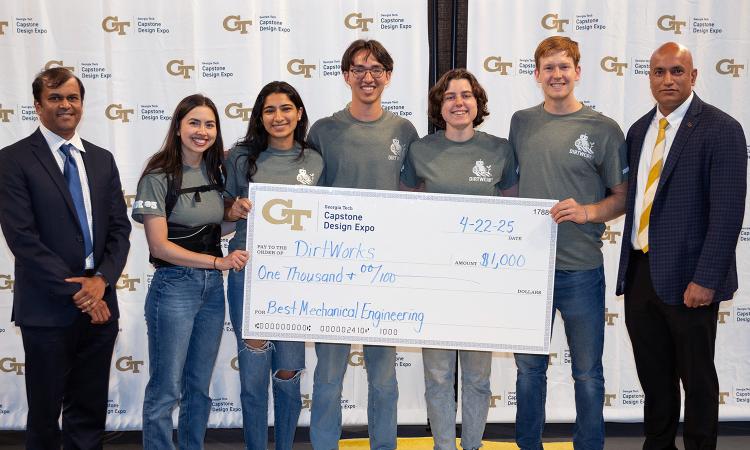
Woodruff School Innovation and Collaboration on Display
Team DirtWorks won best mechanical engineering prize for their autonomous weeding solution for farmers.

Lung Surgery Patients, Lost Hikers Could Benefit from Top Capstone Expo Projects
The fall 2024 showcase of senior design projects across engineering, design, and computing included more than 100 teams presenting their ideas.
(text and background only visible when logged in)
